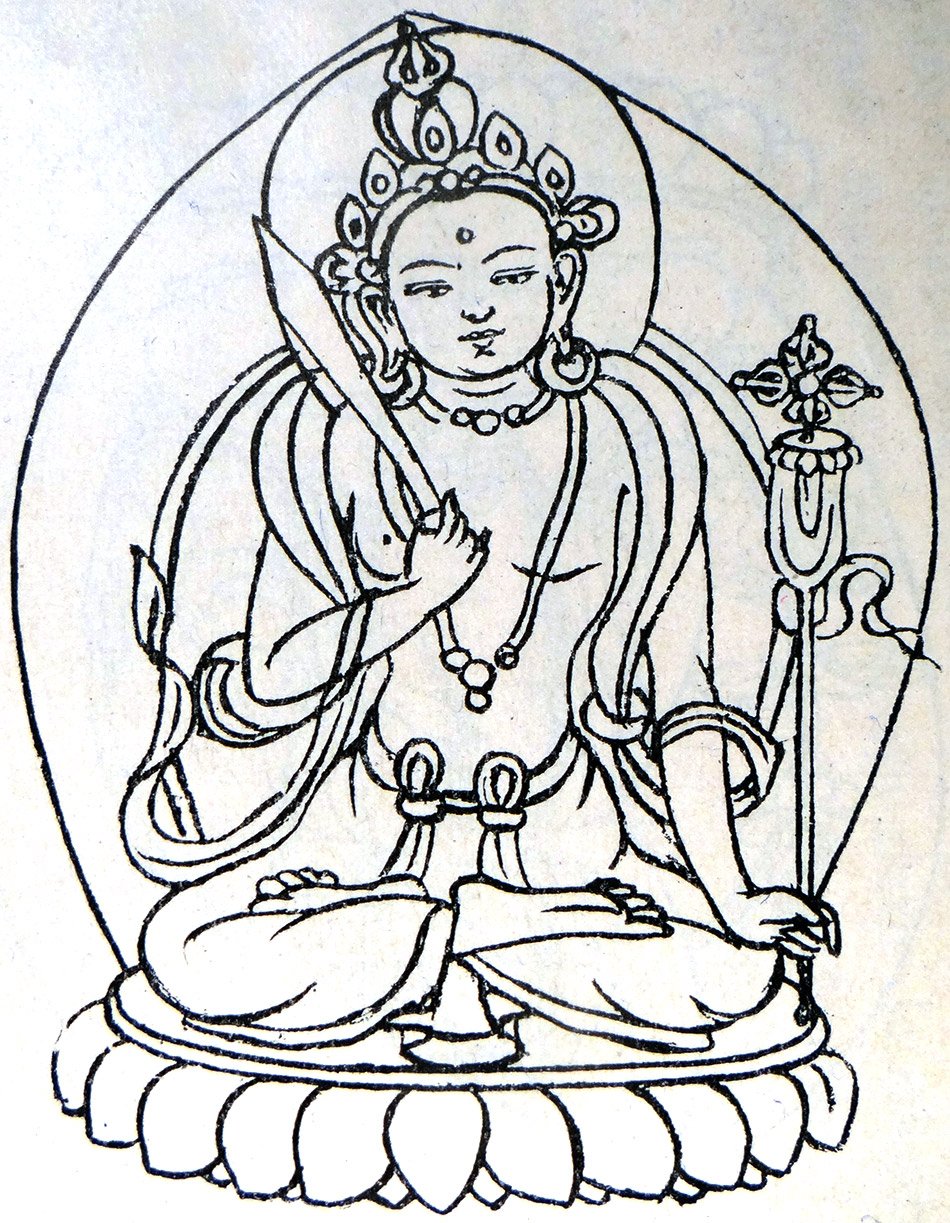The Indian Buddhist Iconography
by Benoytosh Bhattachacharyya | 1958 | 51,392 words | ISBN-10: 8173053138 | ISBN-13: 9788173053139
This page contains an iconography image of Bodhisattva Manjushri and represents figure 66 of the book Indian Buddhist Iconography, based on extracts of the Sadhanamala English translation. These plates and illustrations represent either photographs of sculptures or line-drawing reproductions of paintings or other representations of Buddhist artwork.
Figure 66 - Bodhisattva Mañjuśrī

Figure 66: Mañjuśrī
Like Avalokiteśvara Mañjuśrī is worshipped in all Buddhist countries and has a variety of forms. Mañjuśrī has several names such as Mañjuvajra, Mañjughoṣa, Dharmadhātuvāgīśvara and so forth. As one of the sixteen Bodhisattvas Mañjuśrī is taken as second in the group headed by Maitreya. Mañjuśrī does not find mention in the list headed by Samantabhadta.
In the Mañjuvajra Maṇḍala Mañjuśrī comes as a Bodhisattva in the third circle of deities surrounding the principal god Mañjuvajra who is represented along with his Prajñā or female counterpart. According to Niṣpannayogāvalī, Mañjuśrī should have the same form as the principal deity but he should have no Prajñā.
Next to Avalokiteṣvara, Mañjuśrī is important in the Buddhist pantheon as the God of Learning with the sword for destroying ignorance and the book of transcendental wisdom, His images are numerous, and the Chinese collection presents no less than five different statuettes showing his great popularity in China, Fig 66 illustrates a Nepalese drawing of the Bodhisattva.
Colour: golden;
Symbol: sword and book;
From Chapter 3 (Bodhisattva Mañjuśrī):
The Mahāyānists consider Mañjuśrī to be one of the greatest Bodhisattvas. They believe that the worship of Mañjuśrī can confer upon them wisdom, retentive memory, intelligence and eloquence, and enables them to master many sacred scriptures. His name occurs for the first time in the Āryamañjuśrīmūlakalpa which is obviously a pre-Guhyasamāja work, and then in the Guhyasamāja-tantra which is dated circa 300 A.D.
Many details about Mañjuśrī are to be found in the Svayambhū-purāṇa, dealing with the glories of the Svayambhūkṣetra in Nepal. The Ādibuddha manifested himself here in the shape of a flame of fire, and so it is called the Svayambhūkṣetra (place of the Self- Born). This place is consecrated with a temple of Ādibuddha, and close to it is the Mañjuśrī Hill now known as the Sarasvatīsthāna.
Forty-one Sādhanas in the Sādhanamālā are devoted to the worship of Mañjuśrī, and in them are described several distinct forms of the Bodhisattva. In his simplest form Mañjuśrī carries the sword in his right hand and the Prajñāpāramitā manuscript in his left. In representations sometimes the two symbols are placed on lotuses. Sometimes he is accompanied only by Yamāri, sometimes only by his Śakti or female counterpart, sometimes by Sudhanakumāra and Yamāri and sometimes again by the four divinities, Jālinīprabha (also called Sūryaprabha), Candraprabha, Keśinī and Upakeśinī.
